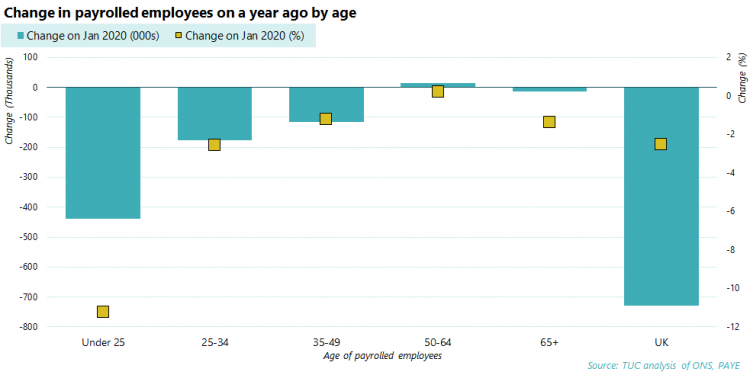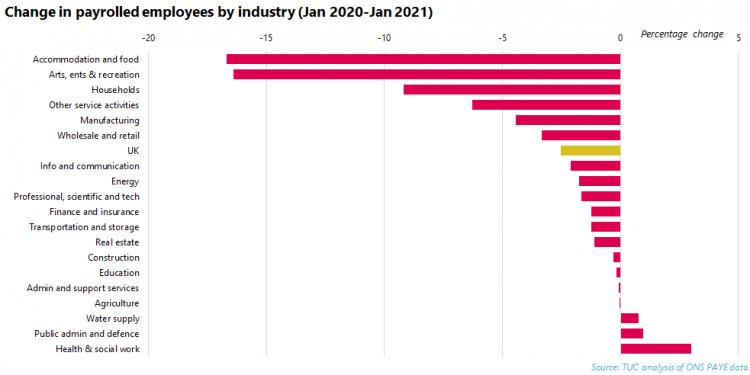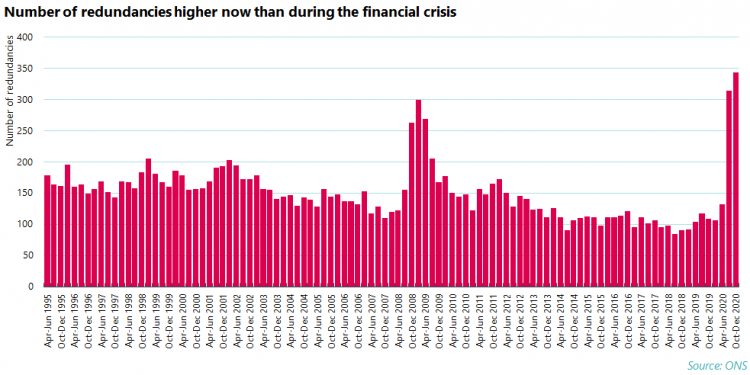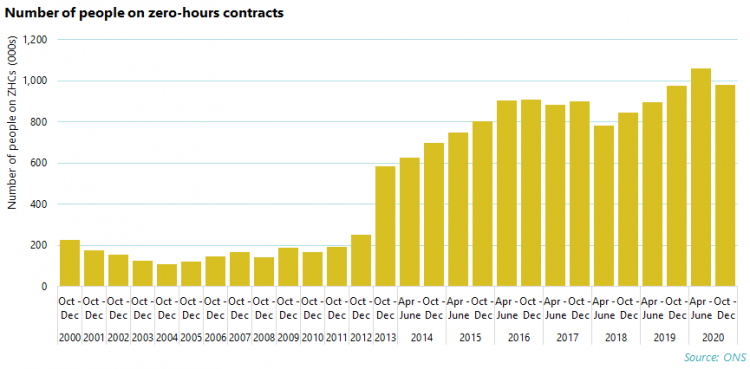Young workers are bearing the brunt of the jobs crisis
The number of employees on payroll dropped by 730,000 between January 2020 and January 2021.
Young workers accounted for a shocking 60% of this drop, with the number of employees aged under 25 falling by 440,000 (11%).

An avoidable crisis
Last June, the TUC warned that young workers were at higher risk of job losses due to the pandemic.
This was due to young workers being more likely to work in the two industries hit hardest by the pandemic: accommodation and food and arts and entertainment.
1-in-5 workers aged 25 and under work in these two sectors, compared to 6% of workers older than 25.
This seems to be what we're seeing now.
Alongside the fall in the number of young employees, the latest payroll data shows big falls in the number of employees in these two industries.

At the time, we called for an ambitious job guarantee scheme that provided good-quality, new jobs with a public benefit for all workers who wanted one, with early access for young workers.
The government did introduce the Kickstart scheme, a watered down version of this scheme, available to young people only, which has so far seen just 2,000 young people start jobs.
This must urgently be revamped to ensure it’s a success.
Redundancies and unemployment
It’s not only young people being hit by job losses. The overall unemployment rate rose to 5.1 per cent in Oct-Dec 2020.
This is the first time in five years that it’s gone above 5 per cent.
And the number of redundancies was above 300,000 for the second consecutive quarter – the first time this has happened on record.

The pandemic has also seen a steep rise in the number of people on Universal Credit (UC). There are now 6 million people on UC, an increase of 98 per cent since March 2020.
The situation would undoubtedly be worse if not for the furlough scheme. As of the end of December 2020, 3.8 million jobs remained furloughed.
It’s vital that the government extends the furlough scheme until the end of the year to provide certainty for both workers and employers.
We know that job losses are triggered when there is uncertainty about the future of the furlough scheme.
We also need to strengthen the safety net for those who do lose their jobs. This must include an urgent overhaul of the benefits system, with both the basic level of UC and legacy benefits increased to at least 80 per cent of the real living wage.
The cruel elements of the system, such as the benefits cap, five-week wait, two-child limit and the rules around no-recourse-to-public-funds, must be scrapped.
Zero-hours contracts
Too many of those who are in work are employed on insecure contracts. New data on zero-hours contracts (ZHCs) shows that just under a million workers remain employed on a ZHC. This is a record high for the Oct-Dec period.
ZHC data is not seasonally adjusted, so data should be compared to the same quarter in other years, rather than quarter-to-quarter.
Health and social work and accommodation and food are the two industries with the highest percentage of, with around 1-in-5 workers in each being employed on a ZHC.

A million workers on insecure ZHCs is a million too many. The government must use its much-delayed employment bill to ban zero-hours contracts once and for all.
Time to create jobs
Today’s labour market data shows the need for long-term investment.
The furlough scheme is helping to protect jobs, and must be extended, but this needs to be done alongside job creation.
Fast-tracking spending now on green housing, infrastructure and our public services can create good quality, well-paid jobs in the parts of the country that need them most. Research carried out for the TUC by Transition Economics has shown that fast tracking spending on projects such as broadband, green technology, transport and housing could deliver a 1.24 million jobs boost by 2022.
Investing to quickly fill existing public service vacancies and staff gaps would create a further 600,000 jobs.
It’s time for the government to address the growing labour market crisis and begin to invest in jobs for the future. This must be underpinned by a stronger social safety net.
Stay Updated
Want to hear about our latest news and blogs?
Sign up now to get it straight to your inbox
